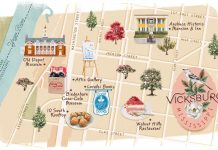
There I stood on stage, palms sweating, sheet music in front of me. I’d spent a long weekend studying songwriting, and the days of practicing and planning had come down to this. I took a deep breath, lifted my violin to my chin, and began to play. There’s a part in the piece that repeats, and as I moved through it the second time, I became less aware of my nerves and more in tune with how audience members were responding, tapping their feet and nodding their heads. I melted into the music.
This performance was supposed to be the culmination of my time at the John C. Campbell Folk School and, in many ways, it was. But, as I later learned, the experience resonated well beyond the weekend.
 The folk school was founded in 1925 in the Danish tradition of noncompetitive education. (“Process not production.”) Located in Brasstown, North Carolina, it aims to preserve Appalachian arts and crafts traditions and offers weeklong and weekend classes in disciplines ranging from blacksmithing and woodworking to weaving, painting, and songwriting. The 300-acre campus also has a retail craft shop and hosts concerts and dances for people who just want to drop in for a few hours.
The folk school was founded in 1925 in the Danish tradition of noncompetitive education. (“Process not production.”) Located in Brasstown, North Carolina, it aims to preserve Appalachian arts and crafts traditions and offers weeklong and weekend classes in disciplines ranging from blacksmithing and woodworking to weaving, painting, and songwriting. The 300-acre campus also has a retail craft shop and hosts concerts and dances for people who just want to drop in for a few hours.
Visiting can make you feel like you’ve stepped back in time. There are no phones or TVs in the rooms, which are sparsely furnished and range from singles to dormitory-style quarters with shared baths. A bell calls everyone to meals, which begin with a blessing or a song and are served family style. You spend all day learning new skills or making things by hand. Life at the school feels simple, connected, pure.
I signed up for songwriting in hopes of reconnecting with my past. I grew up playing violin, but stopped halfway through college. Lately, I’d begun to miss it, and I thought the folk school might be able to help me get back in touch with my musical side.

I must admit, I had my doubts the first day of class. The instructor, Dawn Davis, lived in Wyoming for years and looked the part of a seasoned cowgirl, equally comfortable on a horse or piano bench. She took one look at me and decided what I needed to do to get my creative juices flowing: “Go for a walk and think about colors.”
Right. What kind of hippie-dippy weekend was I in for?
Lacking a better idea, I plunked myself down in one of the practice rooms and just started to play. I came up with a short riff—and it was terrible. So I tried again. And again, and again, until finally I had something I felt comfortable playing for Dawn. From that inkling of an idea, she coaxed the rest of the song out of me. She grew more and more excited the further in the piece we got. She made songwriting feel like a sensory scavenger hunt, and me like I had found the treasure.
As good as Dawn was, the best part of the class was the other students. We were a motley bunch, with wildly different backgrounds. There was a former choral teacher with a ukulele, a mom who dreams of starting a family band, a banjo player who’d made his own instrument, and a young classical flautist who wants to be a librarian.
The initial awkwardness of being in a small group of strangers quickly fell away. Despite the differences in our ages and walks of life, we had something in common: music. We talked about our hometowns, families, and almost ad nauseam about the pieces we were writing. The conversation and songs flowed.

By the time the weekend was over and we climbed that stage for our performance in front of the rest of the school, I was our class’s biggest cheerleader. When the fiddle player nailed the tricky passage in her song, I stifled a shout. This is why I came here, I thought. This moment. Right now.
But I was wrong.
As much as I enjoyed rooting for my new friends and playing my own song on stage, the full benefit of my time at the folk school became apparent after I left. In the weeks since, I’ve noticed an ever-so-subtle shift. I find myself seeking out shows. I’m playing music more. I’m scribbling ideas in a notebook.
And herein, I believe, lies the folk school’s greatest gift.
It’s not just about having a great week or weekend away from the ordinary. It’s about connecting—or reconnecting—with your creative side and making it a part of your everyday life.
Get Crafty
Unleash your inner artist at these acclaimed art education centers
Arrowmont School of Arts and Crafts
Gatlinburg, Tennessee
Set in the heart of Gatlinburg, Arrowmont offers weekend and one- and two-week workshops in textiles, ceramics, woodworking, and more. It’s the oldest craft school in Tennessee, but don’t let that fool you: The school embraces innovation with contemporary class offerings, including mixed media, jewelry making, and photography. arrowmont.org
Penland School of Crafts
Penland, North Carolina
Looking to get far, far away from it all? Penland School spans an impressive 420 acres in the Blue Ridge Mountains; the picturesque campus alone is worth a trip. Each year, some 1,400 people attend one-, two-, and eight-week workshops on printmaking, sculpture, metalworking, and other crafts. Many more—some 14,000—pass through as visitors. penland.org
This article appears in our Spring/Summer 2018 issue of Southbound.














